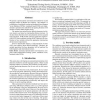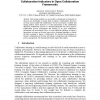INTERSPEECH
2010
13 years 10 months ago
2010
We present a pronunciation error detection method for second language learners of English (L2 learners). The method is a combination of confidence scoring and landmark-based Suppo...
IANDC
2011
13 years 10 months ago
2011
The present paper introduces a new model for teaching randomized learners. Our new model, though based on the classical teaching dimension model, allows to study the influence of...
ICALT
2010
IEEE
14 years 27 days ago
2010
IEEE
This paper describes the development and evaluation of Synote, a freely available accessible web based application that makes multimedia web resources (e.g. podcasts) easier to ac...
HIS
2009
14 years 1 months ago
2009
The diversity of learning abilities between learners in the virtual classroom is wider than those in traditional classroom. It is difficult to prepare a suitable teaching material ...
HCI
2009
14 years 1 months ago
2009
In this paper we take a closer and in-depth look at initial results obtained from a previous novel experiment conducted with a 3D subliminal teaching Intelligent Tutoring System. S...
HCI
2009
14 years 1 months ago
2009
This paper describes two affect-sensitive variants of an existing intelligent tutoring system called AutoTutor. The new versions of AutoTutor detect learners' boredom, confusi...
EDM
2009
14 years 1 months ago
2009
Data mining methods are successful in educational environments to discover new knowledge or learner skills or features. Unfortunately, they have not been used in depth with collabo...
IMCSIT
2010
14 years 1 months ago
2010
We present a dialogue system for exercising the German subordinate clause word order. The pedagogical methodology we adopt is based on focused tasks: the targeted linguistic struct...
IJOE
2008
14 years 2 months ago
2008
: This paper presents a web-based laboratory for distance learners by incorporating simulation and hardware implementation into web-based e-learning systems. It presents a developm...
JCAL
1998
14 years 3 months ago
1998
The paper presents the main design issues of a distance learning course on Business on the Internet. The instructional design is based on a learner centered instructional stratedy...


